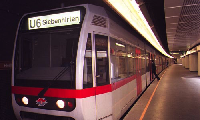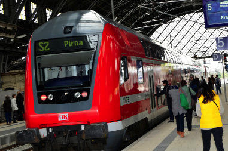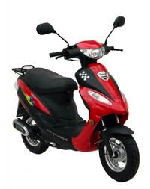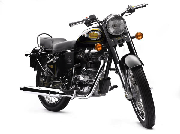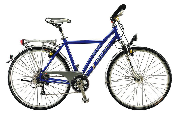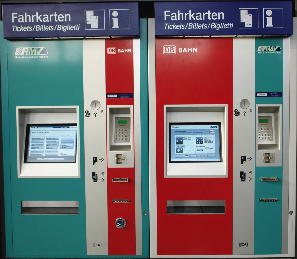| Seite 2 |
Übung 5-2a "Wo, Wohin, Woher" Wiederholung Review exercise.
Interview
Beispiel:
- Wie heißt du? Ich heiße Mary. (First names; keep it simple.) IF YOU NEED TO KNOW HOW TO SPELL A PERSON'S NAME, YOU MUST ASK "WIE SCHREIBT MAN DAS? You need to practice spelling in German.
- Wo wohnst du? Ich wohne in Orangeville.
- Woher kommst du? Ich komme aus New Jersey.
- Wohin fährst du am Wochenende? Ich fahre nach Baltimore.
Ask three people. Use only German. Note the responses below stichwortartig.
| Name | Wohnort | Herkunft | Reiseziel |
|---|---|---|---|
|
|
|
| |
Erzählen Sie! Beispiel: Das ist Mary. Sie wohnt in Benton. Sie kommt aus Chicago. Sie fährt am Wochenende nach Baltimore.
Verkehrsmittel / Öffentliche VerkehrsmittelÜbung 5-2b Wir fahren mit dem / mit der ________ (Maskulinum & Neutrum = "mit dem"; Feminimum = "mit der"). Im BOLT.
| |||||||||||||||
Tipp: on-line German-English dictionariesThere are many on-line reference sources for German. Here are two excellent dictionaries: |
Kulturnotiz: Öffentliche VerkehrsmittelBusse, Züge, Straßenbahnen, U-Bahnen, S-BahnenAs in many European countries, Germany has a dense network of public transportation (öffentliche Verkehrsmittel). Although Germans love their automobiles, many of them could manage well without them. Public transportation is subsidized by local and regional governments, making public transportation quite affordable. Figuring out schedules and how to purchase the right tickets can be daunting at first, but instructions on the ticket vending machines are in several languages and the schedules become clear soon enough. Übung 5-2c: Öffentliche Verkehrsmittel Lesen Sie den Text und beantworten Sie die Fragen im BOLT. Mit dem Zug, mit der Straßenbahn und mit den Bussen sind viele Ziele (destinations) in Deutschland erreichbar (reachable). Der Zug, die U- und S-Bahnen, die Straßenbahn und die Busse sind der "Öffentliche Personen-Nah- und Fernverkehr" (Public Local and Long-Distance Transportation). Die Verbindungen (connections) in der Stadt und in der Region haben die Abkürzung (abbreviation) "ÖPNV" (Öffentlicher Personennahverkehr [Public Local Transportation]). Für Straßenbahn, Bus und kürzere (shorter) Strecken (routes) mit dem Zug muss man Fahrkarten an einem Automaten kaufen.
Die Fahrpreise (fares) sind höher (higher), wenn man weit fährt. Es gibt in Großstädten die "Tarifzonen". Oft sind die Ticketautomaten etwas kompliziert. Wenn man die Fahrkartenautomaten nicht versteht, soll man jemanden fragen. Das "Schwarzfahren" (das Fahren ohne Ticket) kostet in allen Bahnen und Bussen mindestens 40 Euro. Am Bahnhof oder an großen Stationen kann man auch Fahrkarten am Schalter kaufen. Es gibt auch mehrere (several) Sorten von Fahrkarten:
Wortschatz
|
Übung 5-2d: Wie komme ich am besten von...? Corresponding exercise in BOLT. Work with a partner. In this exercise you will be using three preopositions: mit (with), von (from), and zu (to).
These prepositions, along with several others, govern the dative case. An instructional video on the dative case is posted below.
For now, just know the following:
- mit means "with", but in this exercise it means "by means of" a type of transportation (see Übung 5-2b).
- von means "from". In this exercise, von is used to express coming from a place. If the place is a feminine
noun (die Bibliothek), the "from the library" is von der Bibliothek.
If the place is neuter (das Museum) or masculine (der Markt), then "from the Museum" is von dem Museum and
von dem Markt. One often uses the contraction vom Museum and vom Markt.
- zu means "to" in this exercise. Using the examples above, "to the library" is zu der Bibliothek or abbreviated zur Bibliothek. Correspondingly, "to the Museum" and "to the Market" are zu dem Museum and zu dem Markt or abbreviated zum Museum and zum Markt.
You ask the best way to get from one place to another. Your partner responds by suggesting a type of transportation. The graphic image indicates the means of transportation for traveling from one place to another.
Redemittel:
- Frage (question): Wie komme ich am besten vom Markt zur Drogerie?
- Antwort (answer): Sie fahren am besten mit der U-Bahn.
- Frage: Wie komme ich am besten von der Bibliothek zum Metzger?
- Antwort: Sie fahren am besten mit dem Fahrrad.
- der Markt (open market) → die Buchhandlung (bookstore)
- das Museum → der Park
- die Drogerie (drugstore) → das Stadion (stadium)
- die Bibliothek (library) → die Universität
- das Café → der Bahnhof (train station)
- das Wohnungsamt (housing office) → der der Supermarkt
- die Bibliothek → der Supermarkt
- das Café → die Drogerie
- das Stadion → der Markt
- die Buchhandlung → die Universität
- das Stadion → das Wohnungsamt
- das Museum → das Café
- der Park → das Wohnungsamt
- der Markt → die Bibliothek
- die Universität → die Drogerie
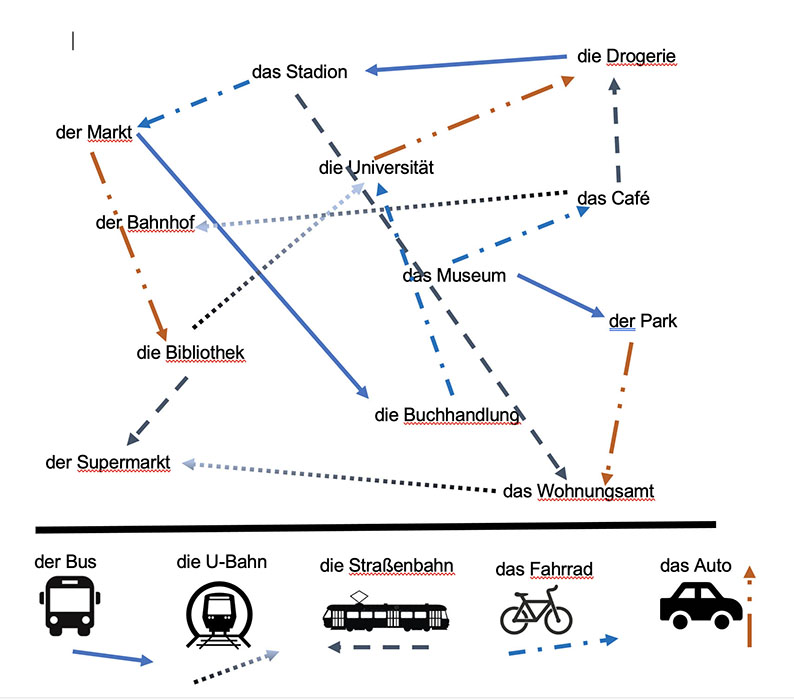
The German pronoun manman does NOT mean "man". The closest equivalent in English is "one", as in "One is reluctant to do that". While "one" as a pronoun sounds stilted in English and is not used often (modern colloquial English instead uses "you", uses the passive voice, or uses some other formulation), man is frequently used in German to express generalities. Examples:
|
Übung 5-2e: Fassen Sie zusammen! (Summarize!) Use Übung 5-2c to formulate a summary list of the best means to get from one place to another. Use the German pronoun "man" as the subject. Zum Beispiel: Man fährt vom Bäcker zur Schule am besten mit dem Fahrrad.; Complete the sentences on BOLT.
- _________________________________________________________________________________________________________
- _________________________________________________________________________________________________________
- _________________________________________________________________________________________________________
- _________________________________________________________________________________________________________
- _________________________________________________________________________________________________________
- _________________________________________________________________________________________________________
- _________________________________________________________________________________________________________
- _________________________________________________________________________________________________________
- _________________________________________________________________________________________________________
- _________________________________________________________________________________________________________
Dative Case: Prepositionsmit, von, and zu are dative prepositions. Eight common German prepositions govern the dative case:
Definite Articles
**Important! Dative plural is often the form forgotten. Plurals of nouns also add an "-n" or "-en": Freunde / mit den Freunden. Case rubrics are located on "Seite 11-Wiederholung".
Übung 5-2f. Dative 1 Video tutorials on the dative case are posted on several pages in this chapter. Quizzes on the video are assigned on BOLT. |
